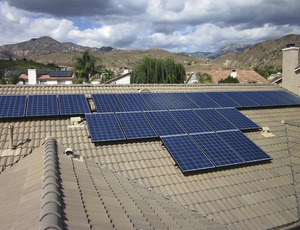
Two years after a boom in multi-megawatt, utility-scale solar photovoltaic projects in the U.S., utilities, solar developers and contractors are gearing up for new sector growth. This time, they have their eyes on smaller but mass-volume rooftop solar installations for residential, commercial, industrial and institutional buildings.
While some commercial, industrial and institutional rooftop projects are relatively large—ranging from 50 kW to 5 MW in capacity—the real volume part of the business is in the residential sector, in which solar PV systems typically are between 1 kW and 20 kW.
According to a September report by the Solar Energy Industries Association (SEIA) and GTM Research, "The addressable [that is, untapped] residential market is still massive compared to the number of customers that have gone solar, leaving an enormous opportunity for growth, and no single strategy to deliver systems to residential rooftops has proven dominant."
SEIA and GTM say that, in the near term, third-party-owned PV systems such as those installed by SolarCity, Verengo and other leading U.S. solar developers "will continue to drive the residential market." Looking to 2014, however, expect new entrants in the residential value chain as either financiers, service providers or both, the report adds.
The average cost of a solar panel tells the tale. The SEIA-GTM report says the price has dropped by 60% since 2011. The average residential PV system now costs only $4.81/watt, and the average non-residential system costs only $3.71/watt. "It is expected that, by the end of 2013, a solar project will have been installed, on average, every four minutes in the U.S.," the report says.
Unlike rooftop solar installations of only a few years ago, which were done largely by smaller contractors, the sector now is dominated by a relatively small group of larger entities skilled at design, permitting and installing rooftop solar systems at a brisk, assembly-line-like pace.
"Our goal is to reach one million customers within the next five years," most of them residential, and to deploy a total of 6,000 MW of solar PV capacity, says Jonathan Bass, spokesman for SolarCity, San Mateo, Calif. The firm has either leased or sold about 400 MW of solar PV systems to about 68,000 customers so far.
Several factors are driving increasing demand for rooftop solar, he says, including customer interest in cleaner energy sources with stable pricing, falling solar panel prices and government incentives.
The vast majority of SolarCity's work is tied to SolarLease or SolarPPA deals under which the company installs a solar system on a customer's roof at no cost, and the customer agrees to either pay a flat monthly lease payment or a fixed price per kWh of electricity to SolarCity. Customers also have the option of buying a rooftop system and having SolarCity install it.
Bass says a key to SolarCity's success has been increased productivity. The company, which is active in 14 states and the District of Columbia, uses sophisticated software to custom-design solar PV systems and its own construction crews to install them. Because of the crews' experience and the repetitive nature of their work, he says, SolarCity gradually has been reducing the time it takes to install rooftop systems.


Post a comment to this article
Report Abusive Comment